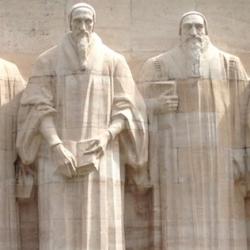In a post yesterday, I urged Protestant churches to move toward a consensus that can be characterized as “classical Protestantism.” That phrase needs some clarification.
The Reformation was not, as I argued at Biola, simply a doctrinal movement. It certainly was that, but it also involved liturgical Reformation. And this liturgical Reformation was not a rejection of liturgy. It was an affirmation of liturgy.
Prior to the Reformation, the liturgy was not leitourgia; it was only minimally the “work of the people” because the people didn’t know the language, didn’t sing the Psalms, rarely shared the Eucharist. The Reformation put the laos back into liturgy. Recent Catholic efforts to revise the liturgy for greater lay participation make the Mass more like Protestant worship (to the horror of traditionalist Catholics).
The Reformation put the Supper as Supper back into the heart of the liturgy, restored the Psalms as the song-book of the church, ensured that worship would be dialogue – ultimately love-talk between Christ and His bride, visibly a dialogue between minister and people. Concretely, Reformation liturgies revised, rather than renounced, the Roman Mass (see the liturgies and analysis in Bard Thompson, Liturgies of the Western Church and Frank Senn’s contribution to The Catholicity of the Reformation).
Reformation liturgics was word-centered, as Carl Trueman pointed out, in a couple of ways. Preaching and teaching took their proper role in the liturgy, and the Mass itself was revised in accord with biblical norms. The Reformers rejected the veneration of the host, and especially in Switzerland the Reformation was marked by iconoclasm.
So, a convergence toward classic Protestantism would involve massive liturgical reform of much of contemporary Evangelical Protestantism, reform that would “feel” Catholic to many. In fact, moving toward a liturgy that looks like a “revised Mass” is a move toward the Reformation.
One other clarification: Classic Protestantism isn’t the end of history, either doctrinally, liturgically, or pastorally. Classic Protestantism should be open to continuing reformation from the word of God in doctrine and practice, and that openness should extend even to doctrines and practices that were fundamental to classic Protestantism.
It’s possible, for instance, that the New Perspective writers are correct about Paul and that our understanding of justification has to be revised accordingly. It’s possible that Protestants haven’t maintained a New Testament balance of faith and works (this is true more of Evangelicalism than of classic Protestantism), and that a proper balance will lead to formulations that sound (but aren’t necessarily) Catholic. And, with an eye to ecumenical concerns, it’s possible that we might find fresh formulations concerning disputed doctrines that satisfy both Catholics and Protestants.
If it’s not open to further reformation from Scripture and the Spirit, then it’s no longer classically Protestant, since Protestantism is foundationally committed to sola scriptura.
And then we’re back on the circus ride – just where we should be.















